You may not know the term “chatoyance”, but you’ve probably seen it. The term derives from the French word “chatoyer”, which means “to shine like a cat’s eye.” If you’ve ever seen a the semi-precious stone tiger’s eye, you get the idea. In woodworking, chatoyance is a similarly striking optical quality in which areas of light and dark grain shift and change position depending on the angle of view. The effect is most pronounced in burls and other wavy-grained woods, where abrupt changes in grain direction cause the concentration of reflected light to change dramatically based on the orientation of the surface of groups of wood cells. Chatoyance is most often considered a desirable effect, and can be enhanced or diminished during the finishing process. There are any number of recipes for maximizing the chatoyance of a finished piece of wood. Most call for a dye stain or other translucent colorant – as apposed to a pigmented stain – and an oil or shellac finish. Here’s one offered by finishing expert Michael Dresdner in answer to a question on producing a tiger eye finish on quilted maple:
What is Chatoyance?
Primarily, chatoyance is a descriptive term often associated with gemology.
Additionally, it is an optical phenomenon where light reflects differently off separate areas of the same stone. The result is a three dimensional appearance.Often, it’s referred to ascat’s eye or tiger’s eye. Below is a definition of chatoyance. While the definition refers to gemstones, many characteristics define chatoyancy in wood, as well.
In gemology, chatoyancy (/ʃəˈtɔɪ.ənsi/ shə-TOY-ən-see), or chatoyance or cat’s eye effect,[1] is an optical reflectance effect seen in certain gemstones. Coined from the French “œil de chat”, meaning “cat’s eye”, chatoyancy arises either from the fibrous structure of a material, as in tiger’s eye quartz, or from fibrous inclusions or cavities within the stone, as in cat’s eye chrysoberyl.[2][3]
source: Chatoyancy (Wikipedia)
Chatoyance in Wood
However, figured woods also show chatoyance. Consequently, light refraction creates the cat’s eye effect. Additionally, the optics are often enhanced with wood finishing.
One cause of chatoyance is the tree being under stress as it grows, causing the grain to curl back on itself. This results in an effect that basically looks like waves within the wood. This is an amazing and beautiful 3D look that changes as you look at the wood from different angles.
In a literal sense, it describes the color morphing properties of certain woods. Due to variations in wood growth patterns, light reflects differently off various areas of the wood. It is similar to how light creates interesting varied patterns when reflecting off a disco ball.
Additionally, stains and dyes enhance the cat’s eye effect. The wavy patterns are an optical illusion.
Which Figured Woods Have Chatoyance?
Although, cat’s eye figure is present in many woods, certain species show it better than others. For example, alder & poplar exhibit very little chatoyancy. What good is chatoyancy that you can’t really see?
Thus, good chatoyant figure in lumber requires three elements:
- Dark wood color tone
- Curly or flame figure
- Wavy grain
- Color tone variations
Koa Wood Cat’s Eye
Accordingly, Koa (acacia) shows it ideally. In additional, it has rich dark color tones that vacillate between red, tan and brown.
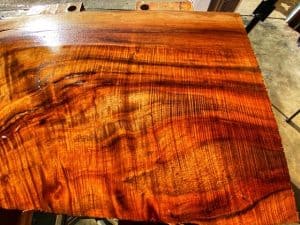
Maple Cat’s Eye Figure
Further, Big Leaf Western Maple shows cat’s eye significantly better than Northern Sugar Maple. The reason is that Big Leaf Maple sapwood has darker color than Hard Maple. Additionally, quilt figure pattern is very irregular and typically only found in western maple. Thus, although Sugar Maple may contain the figure and grain required for cat’s eye, it lacks the color contrast.
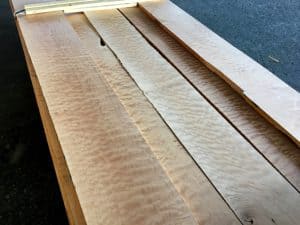
Sapele’s Shimmering Cat’s Eye
One of the best woods for the shimmering 3D figure look of is African Sapele. The uniform deep dark brown color provides a perfect backdrop for chatoyance to project from the wood.
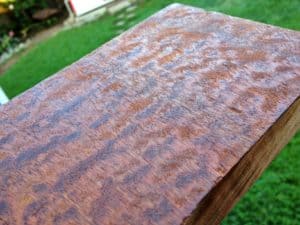
Wild Grain Mahogany Projects Cat’s Eye
Both African and Genuine Mahogany have great colors to show chatoyancy. However, often the grain is too uniform in Genuine Mahogany to reflect the optics. It’s more commonly seen in African Mahogany and to a lesser extent Obeche, Okoume and Limba. This is due to its often wild / irregular grain patterns.
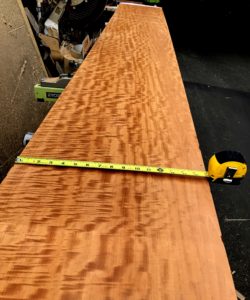
Okoume Wood is Chatoyant & Economical
Okoume wood often produces intense wavy-grain figure on a budget. Light reflects off its dark red/pink color in a stunning way. Thus, even mild figure tends to pop. Additionally, okoume wood commonly contains ribbon figure. Thus, high density cat’s eye is often available at small premium. This is in contrast to hardwoods like Koa & Maple which command high premiums for high figure selections.
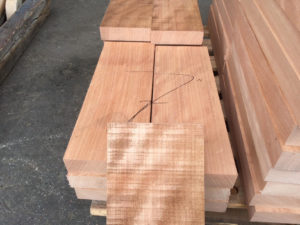
Primavera Lumber Has Wild Ropey Ribbon Figure
Also known as blond mahogany, primavera wood is one of the few chatoyant woods with a pale color tone.
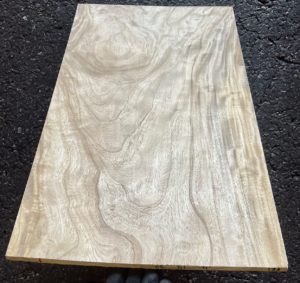
Figured Iroko Lumber Chatoyance
Curly Iroko or figured African Teak shows high levels of contrast and sparkling chatoyancy.


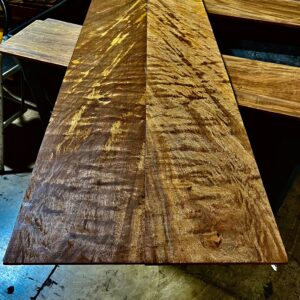
Pingback: Quartersawn Walnut Lumber - Commercial Forest Products
Pingback: Paulownia - Lumber -Wood - Commercial Forest Products - 2019 - 🌳
Pingback: Engineered Walnut Flooring | Width Width Quartersawn - Commercial Forest Products
Pingback: Engineered Quartersawn Walnut Flooring | Wide Width - Commercial Forest Products
Pingback: AYOUS LUMBER | OBECHE WOOD | WAWA | SAMBA - Commercial Forest Products
Pingback: 8/4 Okoume Lumber WOW! - Commercial Forest Products
Pingback: Top 5 Best Wood For Guitar Bodies By A Lumber Professional - Commercial Forest Products
Pingback: Koa Lumber - Figured Wood 2022 - Commercial Forest Products 2022
Pingback: QUILTED MAPLE - Commercial Forest Products 8/4 Quilt Maple- 2021
Pingback: Hardwood Lumber Near Me 2023 - Shocking! Wood Products